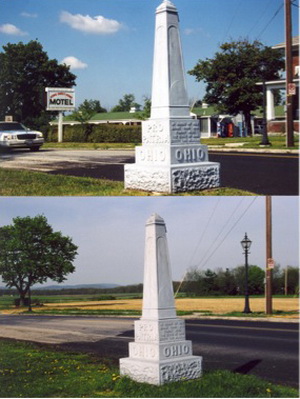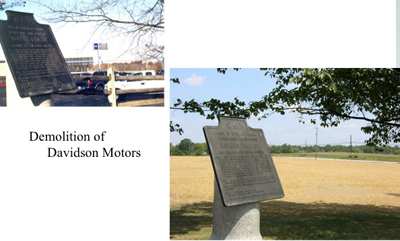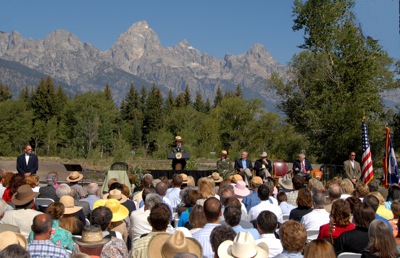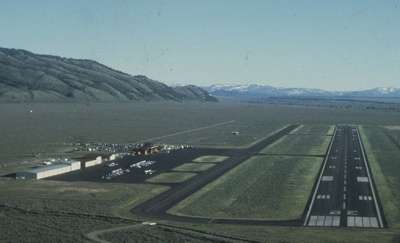
Parks try to control commercial efforts
The battle of Gettysburg occurred more than 100 years ago, but the ancient battleground that marked the turning point of the Civil war can still be visited and experienced today.
However, the natural and historic integrity of Gettysburg National Military Park is threatened by the demands of an increasingly developing world.
Gettysburg National Military Park was established by federal legislation in 1895. Gettysburg was initially administered by Civil War Veterans to commemorate soldiers who lost their lives in the battle, and to preserve the site.
Today, the U.S. Department of the Interior and its National Park Service administers the park and seeks to preserve and interpret the battle at Gettysburg and the military cemetery, the site of the famous address delivered by President Abraham Lincoln. Yet, the difficulties to preserve the park continue to grow.
| At right, the Home Sweet Home Motel, demolished to return the site to its natural appearance (Photo courtesy of Katie Lawhon, National Park Service). Below, next, Davidson Motors, which was also demolished (Photo courtesy of Katie Lawhon, National Park Service). Next, dedication of the Craig Thomas Discovery and Visitor Center at Grand Teton in 2007 (Photo courtesy of Jackie Skaggs, National Park Service). Last, the commercial airport located within Grand Teton’s boundaries (Photo courtesy of Jackie Skaggs, National Park Service). |  |
Land ownership within and outside of the national park boundaries has been one of the largest issues with controlling development, especially at Gettysburg.
“There is still about 1,000 acres of land, 20 percent inside the park, that is not protected,” said Katie Lawhon, management assistant at Gettysburg National Military Park.
Lawhon added that one way to try to combat unwanted development that might affect the natural appearance of the park would be to encourage private land owners to sell Gettysburg National Military Park an easement.
“Say that you and your family own a historic farm at Gettysburg. We would ask you to sell us an easement— We’ll promise to never develop on this site,” Lawhon said.
At Gettysburg, dealing with 20 percent of private land ownership within the park has compelled Gettysburg to work with these private owners to preserve the park from unwanted development within and just outside its boundaries.
Thus, an easement allows partial interest or some legal right to a parcel of land. Land uses and structures that threaten the natural appearance of the park are typically restricted.
Lawhon provided some examples of “commercial structures that had been built and then were subsequently added to the Gettysburg National Military Park boundary by congressional legislation in 1990.
 The park acquired them on a ‘willing seller’ basis and then demolished the structures to return the area to its historic appearance.”
The park acquired them on a ‘willing seller’ basis and then demolished the structures to return the area to its historic appearance.”
These structures include the Home Sweet Home Motel and Davidson Motors.
Similarly, Grand Teton National Park has been keeping an eye on development at its southern border, which is closest to the town of Jackson, Wyoming.
“Because the park was established in the 1950s, there are private in holdings and land that was never sold to the park,” said Jackie Skaggs, public affairs officer for Grand Teton National Park.
Skaggs added that they often try to buy these privately owned lands to prevent development that may be detrimental to the appearance of the park. The park recently bought a rundown property in order to convert the area back to its natural appearance.
“We try to secure federal funding to be one of the potential buyers of the land, but because the land is very expensive, we often have to enter into partnerships with conservation minded individuals until federal money is available,” Skaggs said.
In addition, Grand Teton is currently considering a renewal for an agreement extension for a commercial airport that lies within the park’s boundaries. The airport poses an important debate on whether or not it compromises the natural appearance of the park and if its benefits outweigh this.
“Grand Teton National Park is the only national park in the system with a commercial jetport inside its boundaries. This is one of our sensitive management issues,” Skaggs said.
Along with preserving Grand Teton from unwanted development, the park must deal with a large amount of requests to use the park as a venue for a variety of events, as it is considered one of the top 10 most coveted parks.
Along with these events come media, protestors, and lots of automobiles and equipment. Skaggs mentioned that it is not unlikely for Grand Teton to be the site for a high profile event, as the town of Jackson has many connections to Washington, D.C., or for feature films, ad campaigns or marriages due to the breathtaking beauty of the park.
 Skaggs called the demand to hold these events at Grand Teton a “mixed blessing.” While the events help to promote the park, they also pose many threats to preserving the natural park appearance and experience for visitors.
Skaggs called the demand to hold these events at Grand Teton a “mixed blessing.” While the events help to promote the park, they also pose many threats to preserving the natural park appearance and experience for visitors.
“All parks are striving to remain relevant. If people don’t know the beauty of the park, then they won’t want to help us be stewards to protect the park. However, with these special events come lots of rules and regulations to protect the park.”
For example, when weddings are held at Grand Teton, members of the wedding party are often asked to carpool so that the general public’s experience is not interrupted by an abundance of automobiles parked in front of historic sites.
While Grand Teton receives many special event requests, Jeffery Olson, public affairs officer for the National Park Service headquarters in Washington, D.C., stated, “Few other National Park Service sites have the demand for special events the National Mall receives.”
Perhaps the most pronounced example of commercial exploitation of the National Mall was the National Football League’s “NFL Kickoff Live” festival held at the Mall in 2003. During this event, parts of the Mall were fenced off and visitors were prohibited from enjoying the Mall in its natural sense for the 17-day duration of the event.
The event was considered an appropriate use of the Mall because it was in partnership with “Take Pride in America,” a slogan that promotes volunteerism, and it was an event honoring military personnel. However, large advertisements for Pepsi, Verizon, and other sponsors were clearly displayed at the event.
Kari Cobb, park ranger and spokeswoman for Yosemite National Park, emphasized that, although Yosemite holds events, commercialization in the park is very limited.
“We follow a strict policy against hosting large events that may be detrimental to the park’s visitors or vegetation or events that pose a large monetary reward,” Cobb said.
In addition, Yosemite strives to maintain the park’s natural appearance while still providing visitors with amenities like concessions and gift shops.
 “In the park we try to keep a certain character, we try to keep a rustic look. We restore buildings to the 1920s look by using materials to recreate the rustic woodwork look,” Cobb added.
“In the park we try to keep a certain character, we try to keep a rustic look. We restore buildings to the 1920s look by using materials to recreate the rustic woodwork look,” Cobb added.
So where exactly should the national parks draw the line for commercialization and development?
Lawhon and Skaggs agree that purchasing privately owned lands or obtaining easements is one of the best ways to protect the parks from development that might interfere with the park’s natural appearance.
As Skaggs and Cobb pointed out, events held in the park help promote the parks and provide awareness for their natural beauty; however, measures must be taken to ensure that visitors can still enjoy the national parks in their natural state while these events are taking place.
Olson pointed out that the employees of the National Park Service are guided by the Organic Act of 1916, which created the National Park Service. This act states that the mission of the National Park Service is to protect the parks for the enjoyment of future generations.
“Some people have called this mission improbable, oxymoronic and impossible. It is widely seen as a challenge because we are to do our best so that people enjoy parks today but we must temper our ideas of enjoyment so we leave parks unimpaired for future generations of people to enjoy,” Olson said.
The management policies of 2006, which can be found at http://www.nps.gov/policy/mp/Index2006.htm explain the policy by which the National Park Service manages the parks.
“These policies—and the human application of policy and common sense, working with your neighbors and the local community—are the best ways we know to, as you say, conserve the natural beauty of national parks” Olson concluded.

Comments are Closed